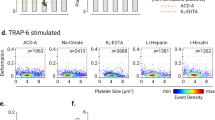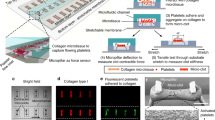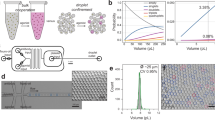Abstract
Haemostasis occurs at sites of vascular injury, where flowing blood forms a clot, a dynamic and heterogeneous fibrin-based biomaterial. Paramount in the clot’s capability to stem haemorrhage are its changing mechanical properties, the major drivers of which are the contractile forces exerted by platelets against the fibrin scaffold1. However, how platelets transduce microenvironmental cues to mediate contraction and alter clot mechanics is unknown. This is clinically relevant, as overly softened and stiffened clots are associated with bleeding2 and thrombotic disorders3. Here, we report a high-throughput hydrogel-based platelet-contraction cytometer that quantifies single-platelet contraction forces in different clot microenvironments. We also show that platelets, via the Rho/ROCK pathway, synergistically couple mechanical and biochemical inputs to mediate contraction. Moreover, highly contractile platelet subpopulations present in healthy controls are conspicuously absent in a subset of patients with undiagnosed bleeding disorders, and therefore may function as a clinical diagnostic biophysical biomarker.
This is a preview of subscription content, access via your institution
Access options
Subscribe to this journal
Receive 12 print issues and online access
$259.00 per year
only $21.58 per issue
Buy this article
- Purchase on Springer Link
- Instant access to full article PDF
Prices may be subject to local taxes which are calculated during checkout





Similar content being viewed by others
References
Jen, C. J. & McIntire, L. V. The structural properties and contractile force of a clot. Cell Motil. 2, 445–455 (1982).
Hvas, A.-M. et al. Tranexamic acid combined with recombinant factor VIII increases clot resistance to accelerated fibrinolysis in severe hemophilia A. J. Thromb. Haemost. 5, 2408–2412 (2007).
Collet, J. P. et al. Altered fibrin architecture is associated with hypofibrinolysis and premature coronary atherothrombosis. Arterioscler. Thromb. Vasc. Biol. 26, 2567–2573 (2006).
Carr, M. E. Development of platelet contractile force as a research and clinical measure of platelet function. Cell Biochem. Biophys. 38, 55–78 (2003).
Cohen, I. & De Vries, A. Platelet contractile regulation in an isometric system. Nature 246, 36–37 (1973).
Young, G. et al. Thrombin generation and whole blood viscoelastic assays in the management of hemophilia: current state of art and future perspectives. Blood 121, 1944–1950 (2013).
Qiu, Y. et al. Platelet mechanosensing of substrate stiffness during clot formation mediates adhesion, spreading, and activation. Proc. Natl Acad. Sci. USA 111, 14430–14435 (2014).
Lam, W. A. et al. Mechanics and contraction dynamics of single platelets and implications for clot stiffening. Nat. Mater. 10, 61–66 (2011).
Kita, A. et al. Microenvironmental geometry guides platelet adhesion and spreading: a quantitative analysis at the single cell level. PLoS ONE 6, e26437 (2011).
Stalker, T. J. et al. Hierarchical organization in the hemostatic response and its relationship to the platelet-signaling network. Blood 121, 1875–1885 (2013).
Nesbitt, W. S. et al. A shear gradient-dependent platelet aggregation mechanism drives thrombus formation. Nat. Med. 15, 665–673 (2009).
Kroll, M. H., Hellums, J. D., McIntire, L. V., Schafer, A. I. & Moake, J. L. Platelets and shear stress. Blood 88, 1525–1541 (1996).
Weisel, J. W. Biophysics. Enigmas of blood clot elasticity. Science 320, 456–457 (2008).
Schwarz Henriques, S., Sandmann, R., Strate, A. & Köster, S. Force field evolution during human blood platelet activation. J. Cell Sci. 125, 3914–3920 (2012).
Liang, X. M., Han, S. J., Reems, J.-A. A., Gao, D. & Sniadecki, N. J. Platelet retraction force measurements using flexible post force sensors. Lab Chip 10, 991–998 (2010).
Suzuki-Inoue, K. et al. Involvement of Src kinases and PLCγ2 in clot retraction. Thromb. Res. 120, 251–258 (2007).
Litvinov, R. I., Gorkun, O. V., Owen, S. F. & Shuman, H. Polymerization of fibrin: specificity, strength, and stability of knob-hole interactions studied at the single-molecule level. Blood 106, 2944–2951 (2005).
Litvinov, R. I. et al. Polymerization of fibrin: direct observation and quantification of individual B:b knob–hole interactions. Blood 109, 130–138 (2007).
Engler, A. et al. Embryonic cardiomyocytes beat best on a matrix with heart-like elasticity: scar-like rigidity inhibits beating. J. Cell Sci. 121, 3794–3802 (2008).
Paszek, M. J. et al. Tensional homeostasis and the malignant phenotype. Cancer Cell 8, 241–254 (2005).
Burridge, K. & Wittchen, E. The tension mounts: Stress fibers as force-generating mechanotransducers. J. Cell Biol. 200, 9–19 (2013).
De Gennes, P.-G. Scaling Concepts in Polymer Physics (Cornell University Press).
Shah, J. & Janmey, P. Strain hardening of fibrin gels and plasma clots. Rheol. Acta 36, 262–268 (1997).
Godwin, H. & Ginsburg, D. May–Hegglin anomaly: a defect in megakaryocyte fragmentation? Br. J. Haematol. 26, 117–127 (1974).
Shcherbina, A. et al. WASP plays a novel role in regulating platelet responses dependent on αIIbβ3 integrin outside-in signalling. Br. J. Haematol. 148, 416–427 (2010).
Pedersen, J. A. & Swartz, M. A. Mechanobiology in the third dimension. Ann. Biomed. Eng. 33, 1469–1490 (2005).
Von Philipsborn, A. C. et al. Microcontact printing of axon guidance molecules for generation of graded patterns. Nat. Protoc. 1, 1322–13228 (2006).
Jirousková, M., Jaiswal, J. K. & Coller, B. S. Ligand density dramatically affects integrin αIIbβ3-mediated platelet signaling and spreading. Blood 109, 5260–5269 (2007).
Polio, S. R., Rothenberg, K. E., Stamenović, D. & Smith, M. L. A micropatterning and image processing approach to simplify measurement of cellular traction forces. Acta Biomater 8, 82–88 (2012).
Tse, J. R. & Engler, A. J. Stiffness gradients mimicking in vivo tissue variation regulate mesenchymal stem cell fate. PLoS ONE 6, e15978 (2011).
Engler, A. J., Sen, S., Sweeney, H. L. & Discher, D. E. Matrix elasticity directs stem cell lineage specification. Cell 126, 677–689 (2006).
Maloney, J. M., Walton, E. B., Bruce, C. M. & VanVliet, K. J. Influence of finite thickness and stiffness on cellular adhesion-induced deformation of compliant substrata. Phys. Rev. E 78, 041923 (2008).
Tse, J. R. & Engler, A. J. Preparation of hydrogel substrates with tunable mechanical properties. Curr. Protoc. Cell Biol. (2010) Ch. 10 Unit 10.16.
Sabass, B., Gardel, M., Waterman, C. & Schwarz, U. High resolution traction force microscopy based on experimental and computational advances. Biophys. J. 94, 207–220 (2008).
McCabe White, M. & Jennings, L. K. Platelet Protocols: Research and Clinical Laboratory Procedures (Academic).
Gersh, K. C., Nagaswami, C. & Weisel, J. W. Fibrin network structure and clot mechanical properties are altered by incorporation of erythrocytes. Thromb. Haemost. 102, 1169–1175 (2009).
Collet, J.-P. P., Shuman, H., Ledger, R. E., Lee, S. & Weisel, J. W. The elasticity of an individual fibrin fiber in a clot. Proc. Natl Acad. Sci. USA 102, 9133–9137 (2005).
Acknowledgements
The authors wish to thank A. Shaw of the Parker H. Petit Institute for Bioengineering and Bioscience at the Georgia Institute of Technology (GT); N. Anthony and the Emory University Integrated Cellular Imaging Microscopy Core of the Children’s Pediatric Research Center; and the GT Institute for Electronics and Nanotechnology (IEN) cleanroom. Financial support provided by NIH R01 (HL121264), NIH U54 (HL112309), and NSF CAREER (1150235) to W.A.L., as well as an AHA Postdoctoral Fellowship to D.R.M. are acknowledged. D.R.M. thanks Christy R. Dillon and Gabriel A. Kwong for comments and discussion.
Author information
Authors and Affiliations
Contributions
D.R.M. and W.A.L. conceived of and designed the platelet-contraction experiments. D.R.M., Y.Q., A.C.B., J.C.C., B.A., M.L.S., T.S. and W.A.L. designed and tested the platelet-contraction cytometer. D.R.M., M.T., D.C., J.C., Y.S., J.B., R.T., R.G.M., S.T.B., C.B., M.B. and A.F.-N. performed experiments. M.E.F. designed and wrote image analysis algorithms. D.R.M. and W.A.L. analysed data and wrote the manuscript.
Corresponding author
Ethics declarations
Competing interests
The authors declare no competing financial interests.
Supplementary information
Supplementary Information
Supplementary Information (PDF 2845 kb)
Supplementary Information
Supplementary movie 1 (AVI 415 kb)
Supplementary Information
Supplementary movie 2 (AVI 440 kb)
Supplementary Information
Supplementary movie 3 (AVI 407 kb)
Supplementary Information
Supplementary movie 4 (AVI 131940 kb)
Rights and permissions
About this article
Cite this article
Myers, D., Qiu, Y., Fay, M. et al. Single-platelet nanomechanics measured by high-throughput cytometry. Nature Mater 16, 230–235 (2017). https://doi.org/10.1038/nmat4772
Received:
Accepted:
Published:
Issue Date:
DOI: https://doi.org/10.1038/nmat4772
This article is cited by
-
Cell-mediated nanoparticle delivery systems: towards precision nanomedicine
Drug Delivery and Translational Research (2024)
-
Detection of cellular traction forces via the force-triggered Cas12a-mediated catalytic cleavage of a fluorogenic reporter strand
Nature Biomedical Engineering (2023)
-
A familial case of MYH9 gene mutation associated with multiple functional and structural platelet abnormalities
Scientific Reports (2022)
-
Ex vivo anticoagulants affect human blood platelet biomechanics with implications for high-throughput functional mechanophenotyping
Communications Biology (2022)
-
A reversible shearing DNA probe for visualizing mechanically strong receptors in living cells
Nature Cell Biology (2021)



